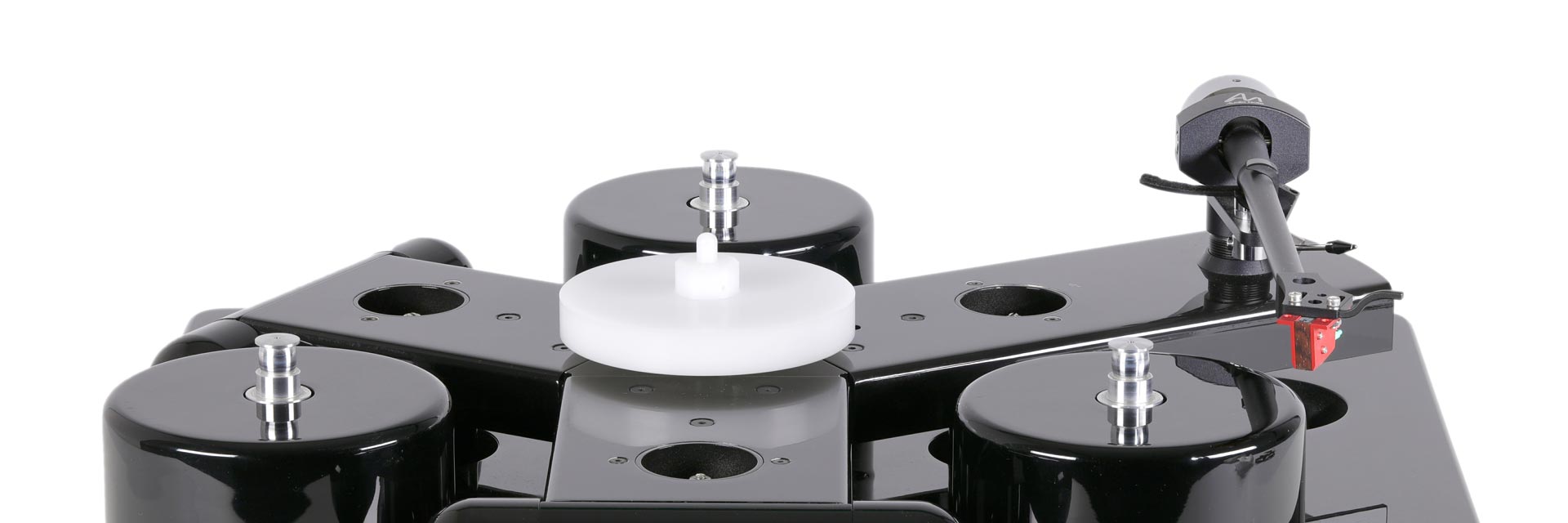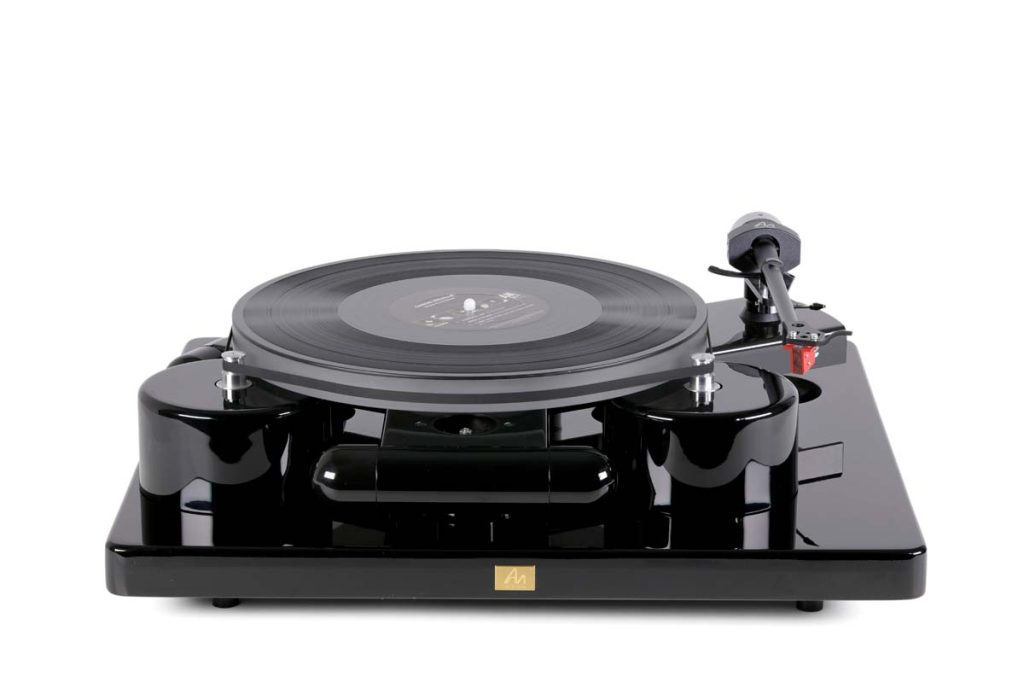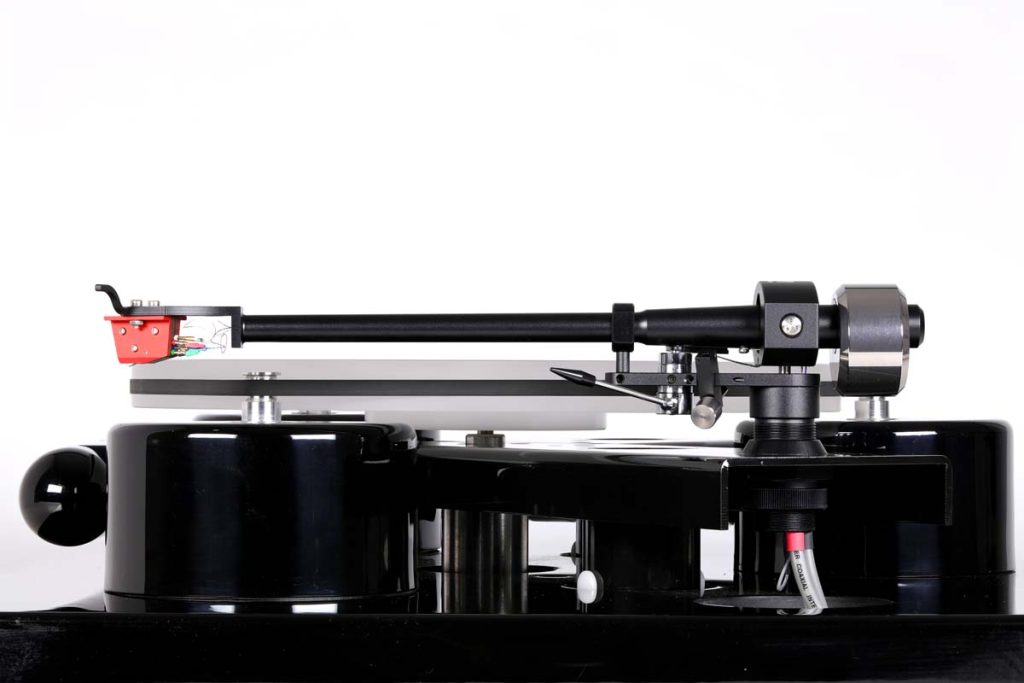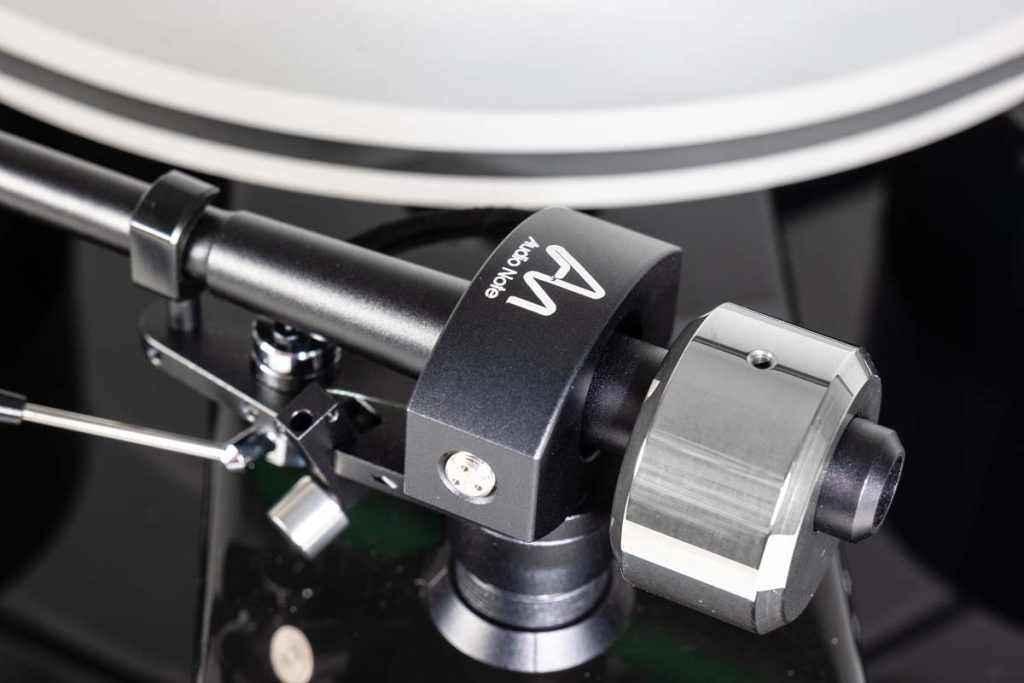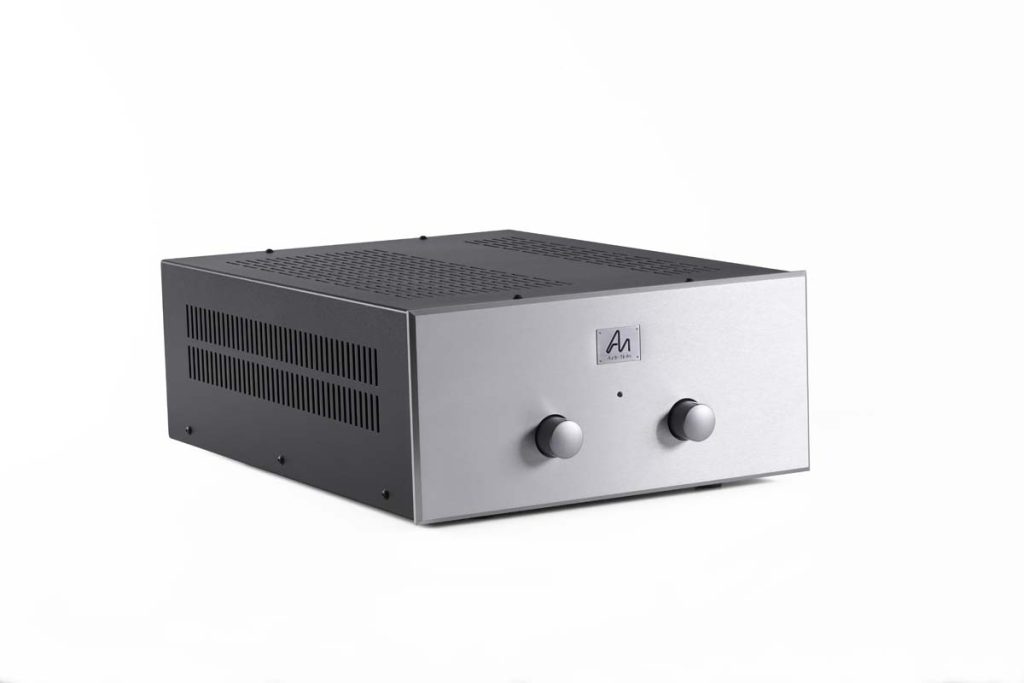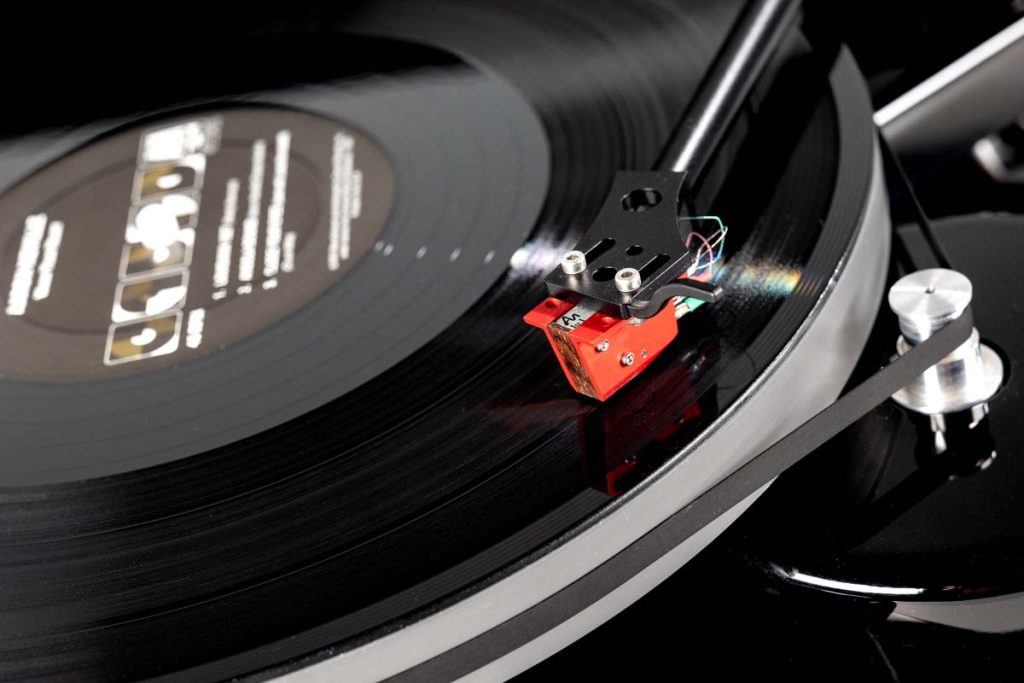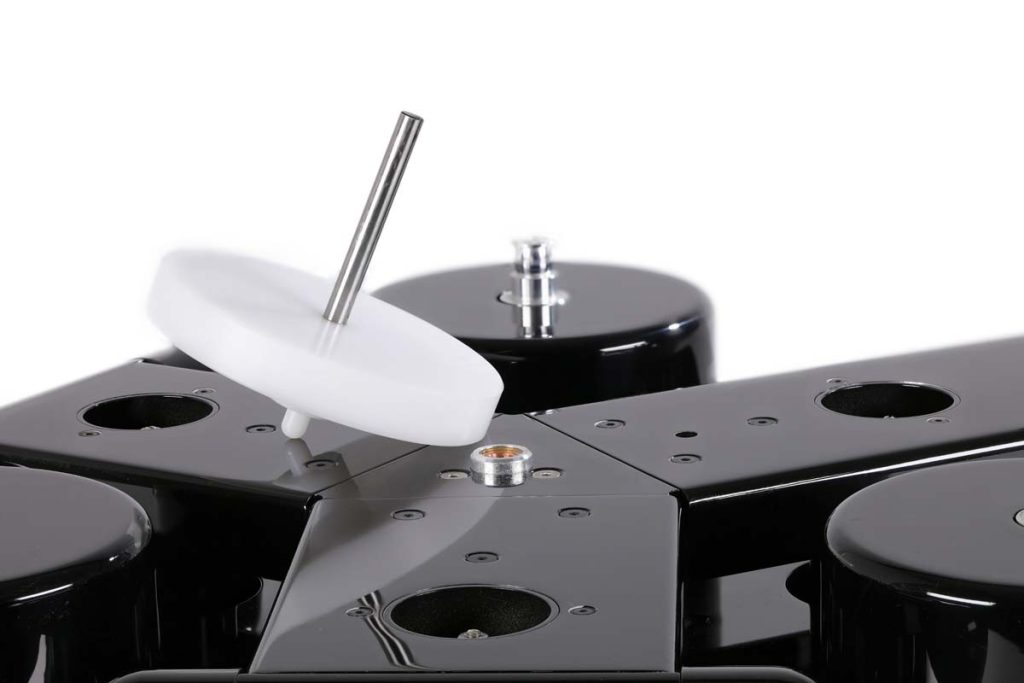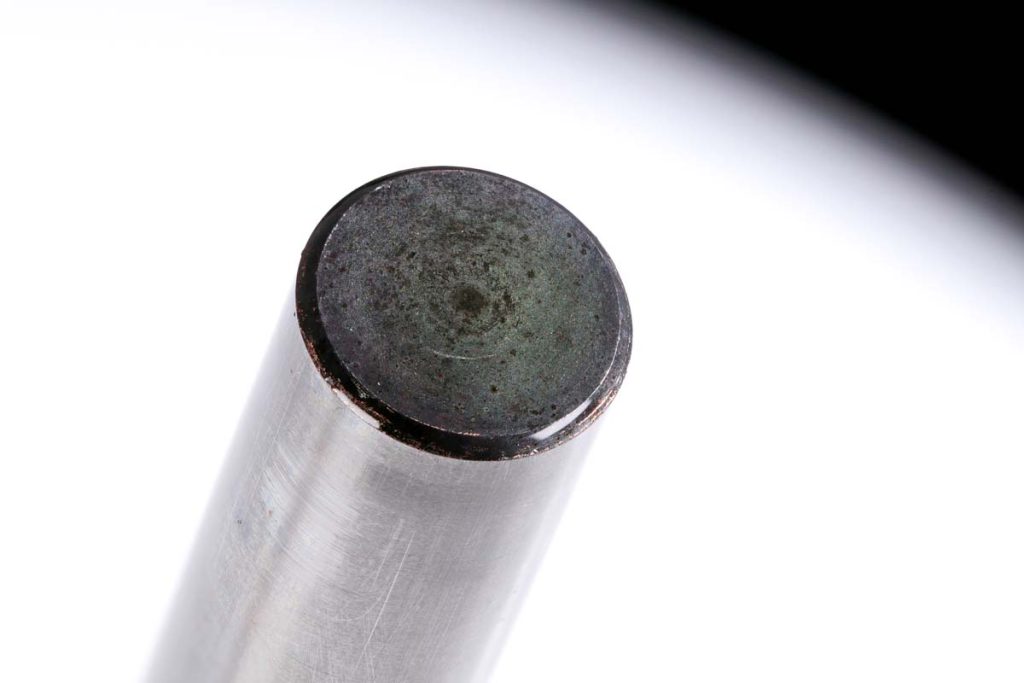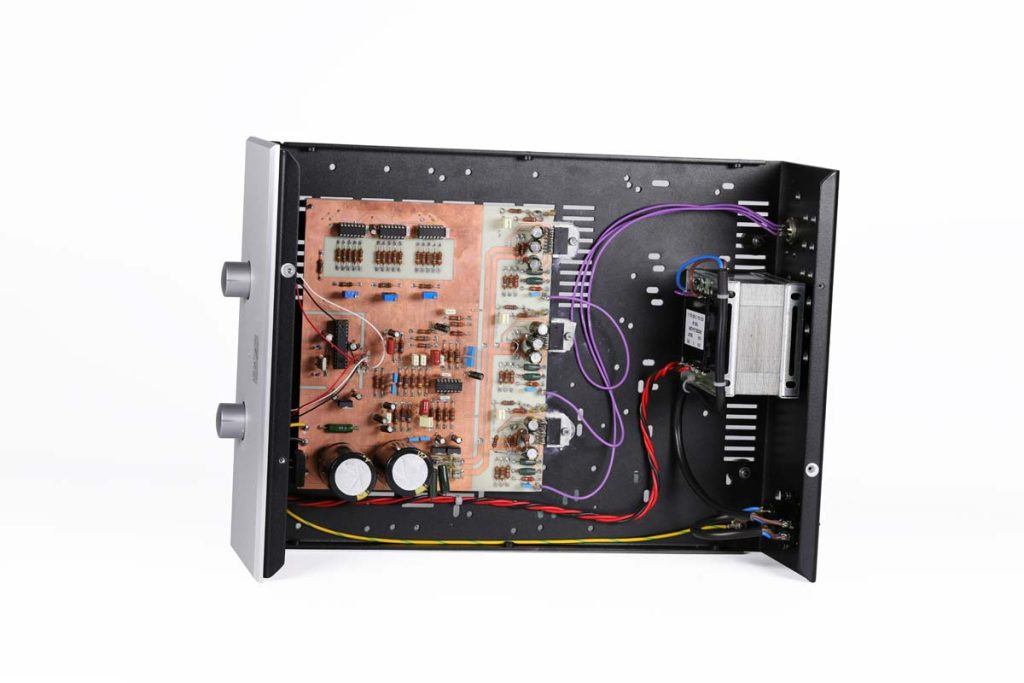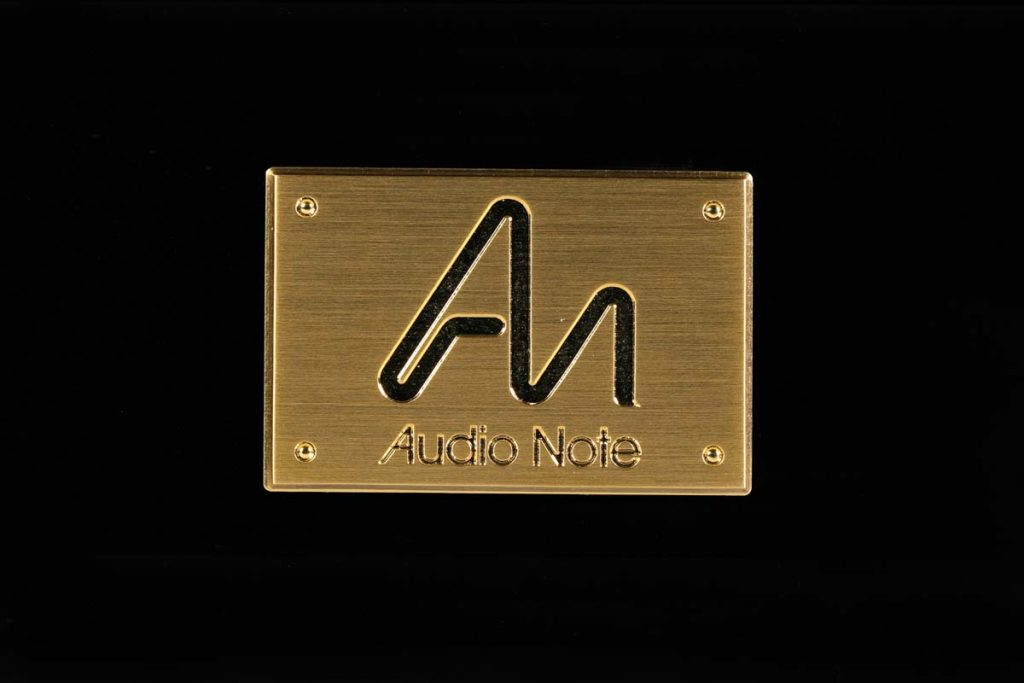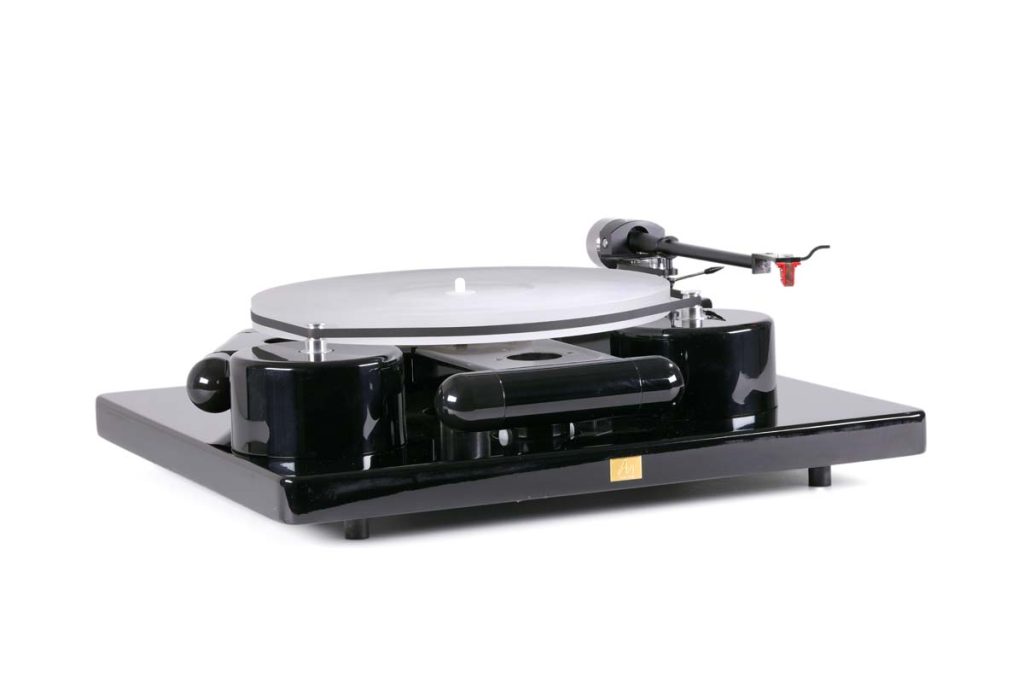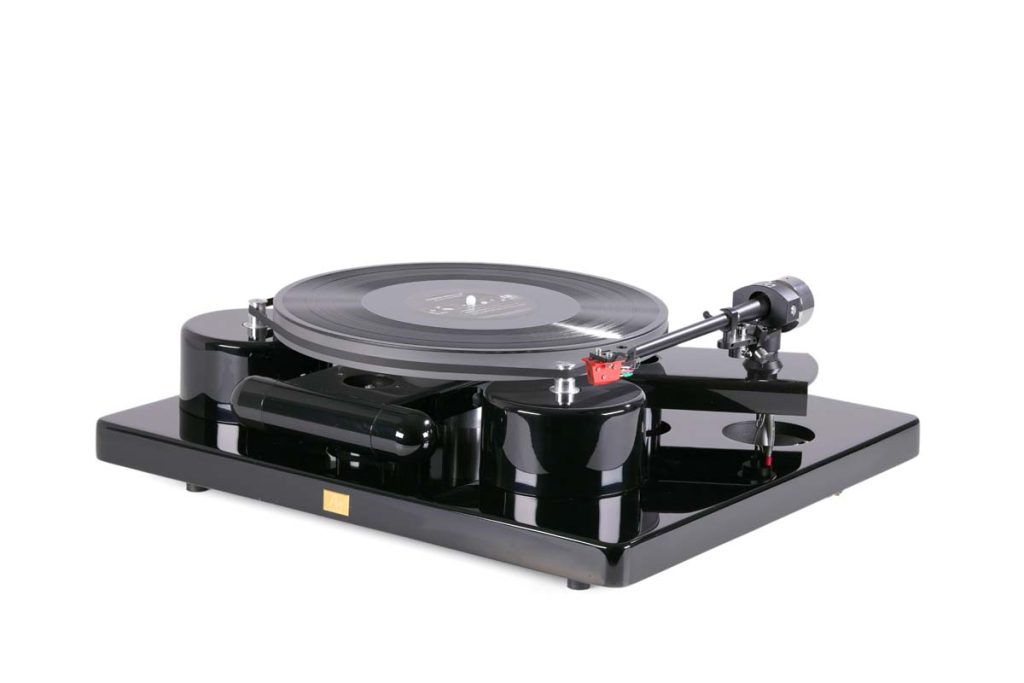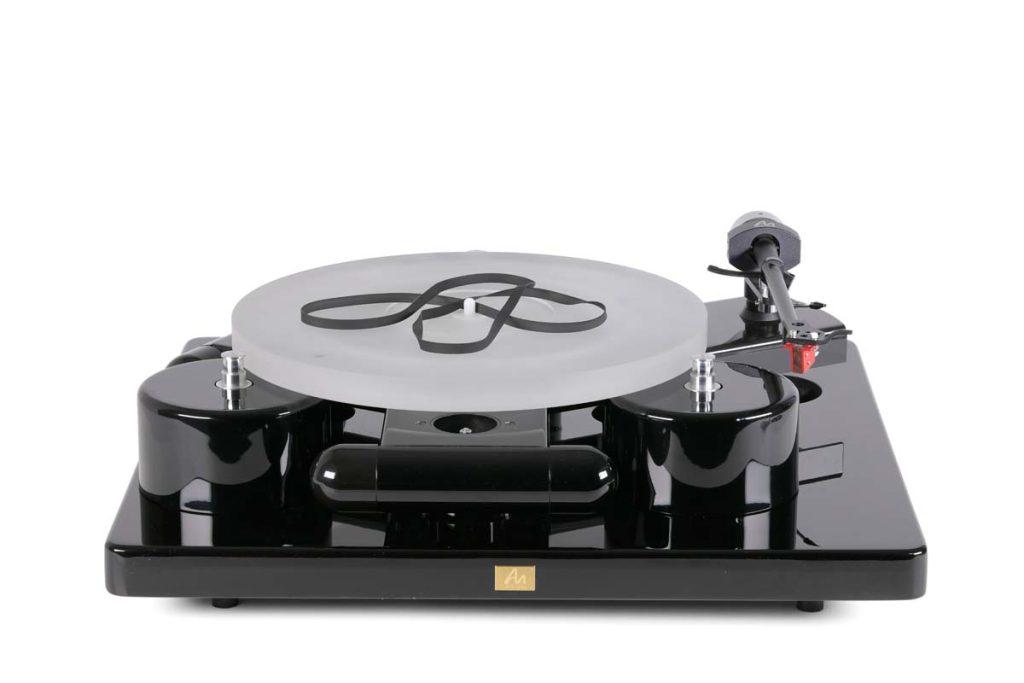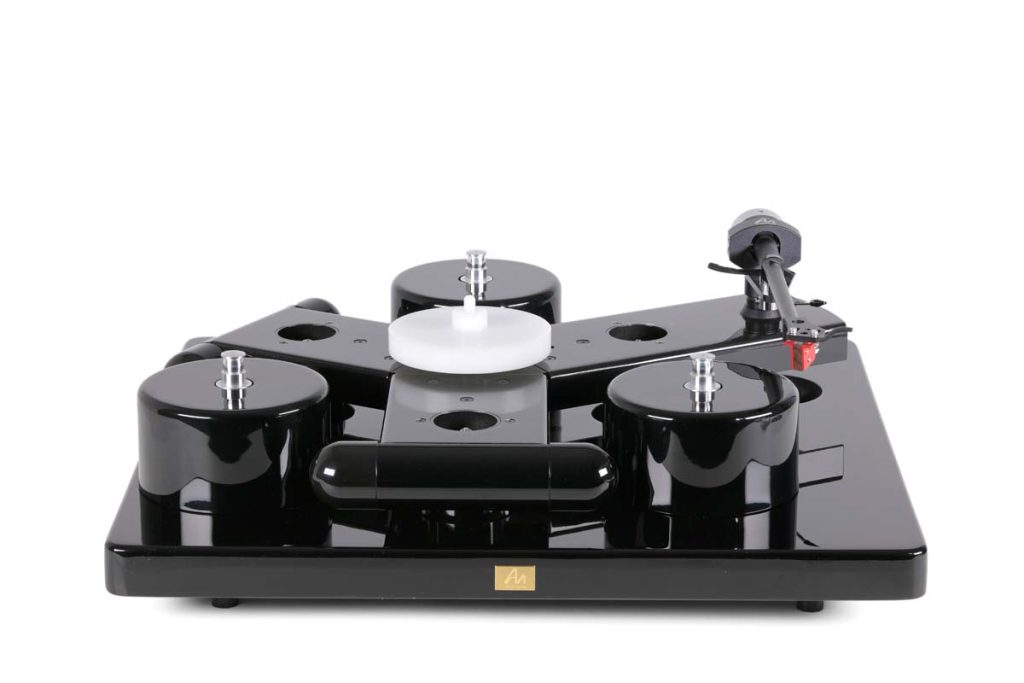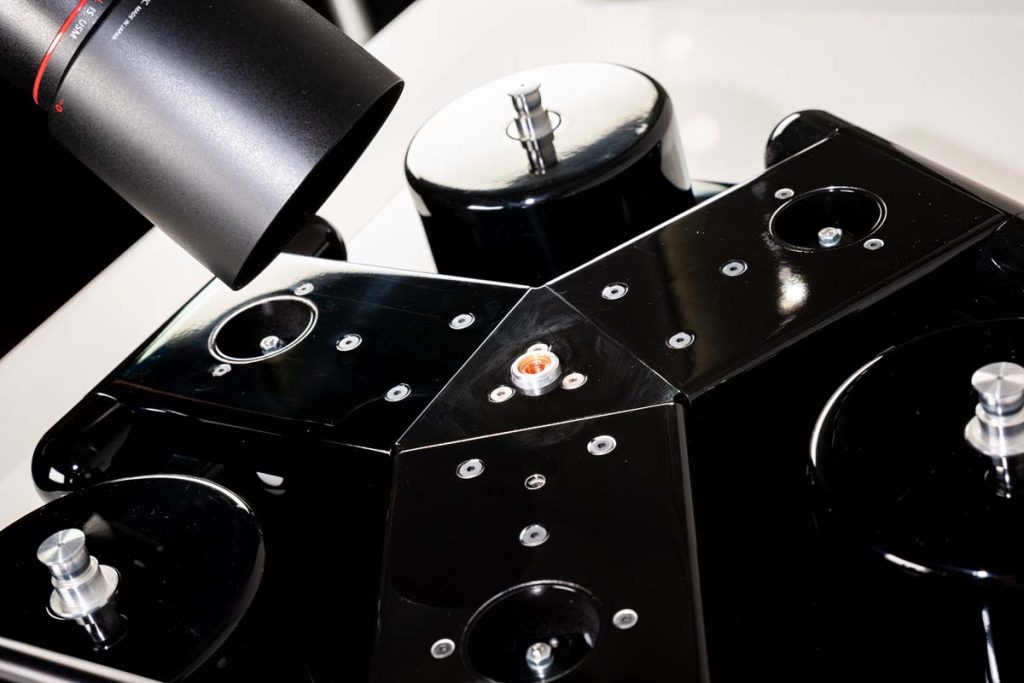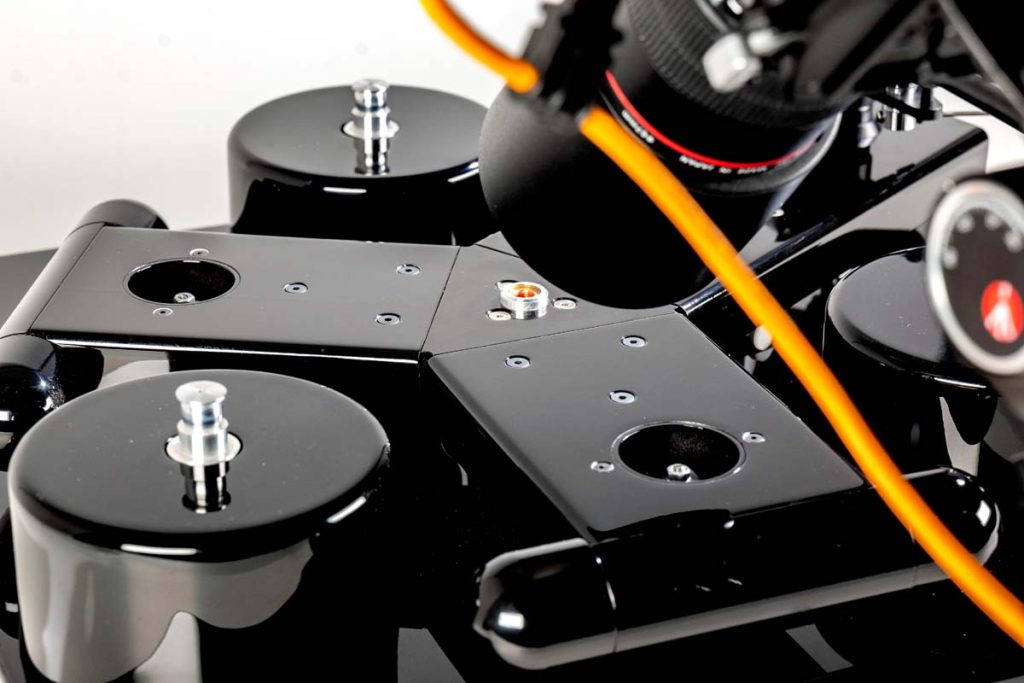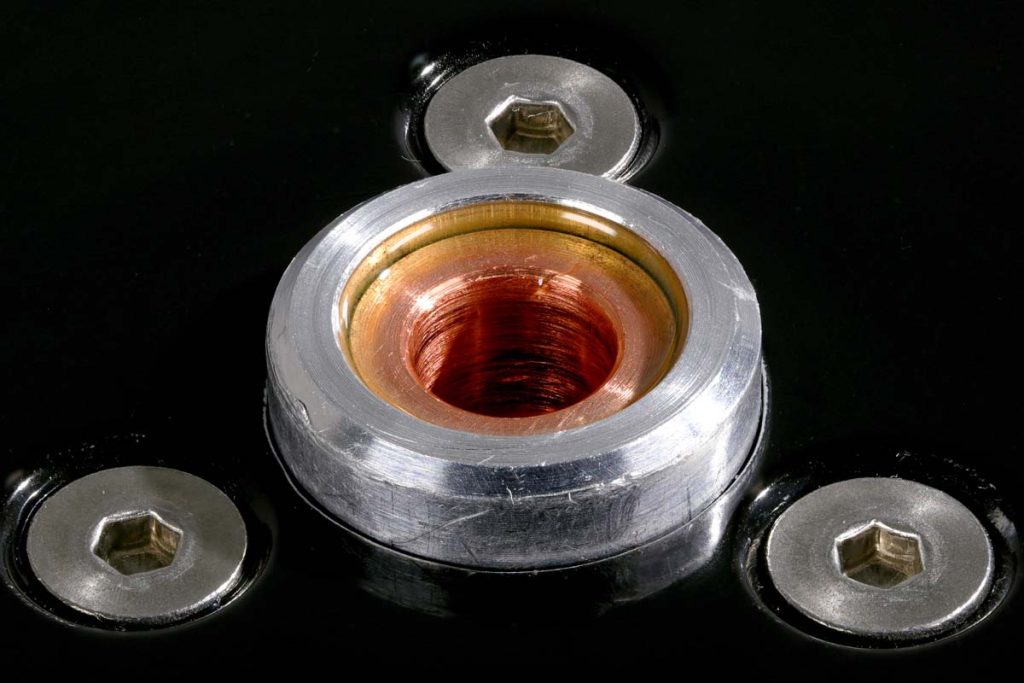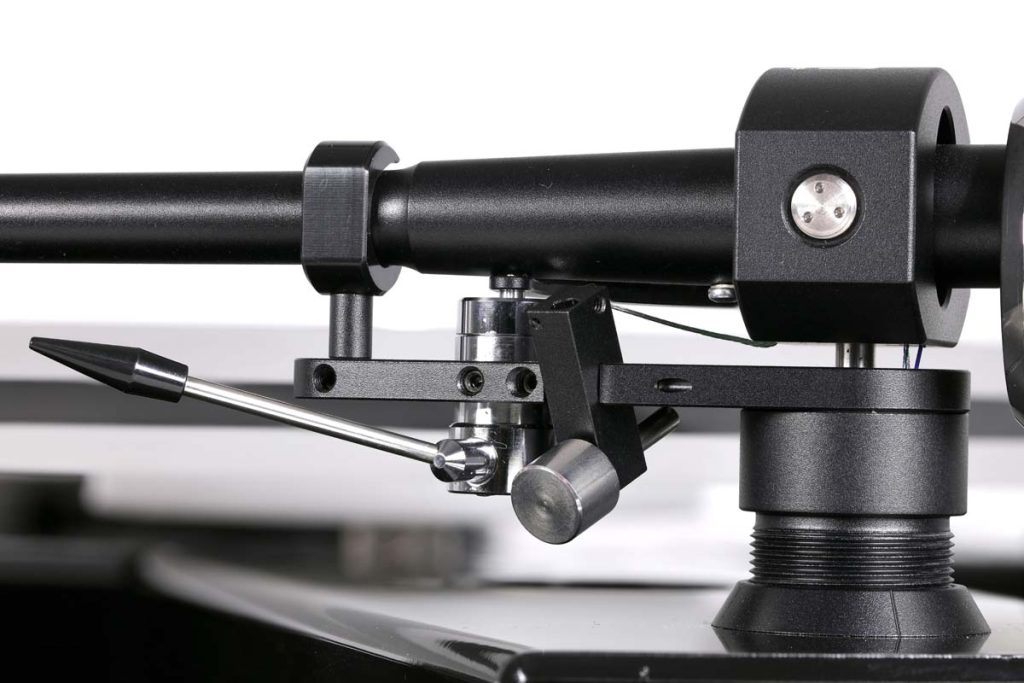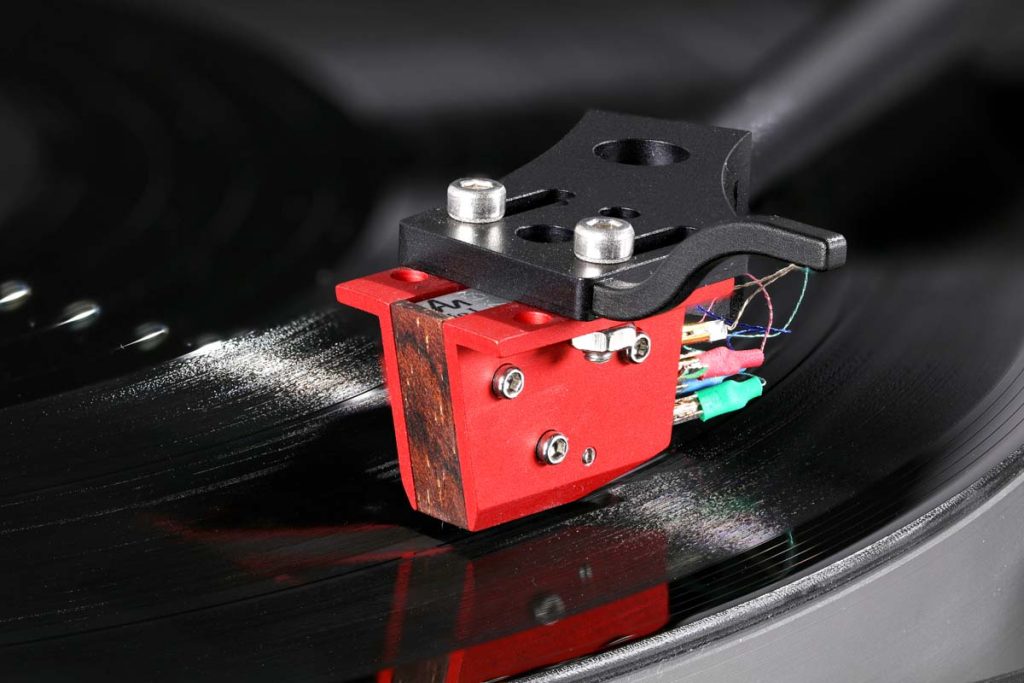Boom — clap!
The Audio Note TT Three brings back the dashing triple-motor design. Powerful motors and low moving masses – like in racing and aeronautics.
Picture a tranquil living room, with two relaxed guests sitting on the sofa. A third man, the host, carefully puts a vinyl on. The stylus descends into the empty space between two tracks. Silence, then subtle crackling and anticipation fill the air. The third man, who only looks relaxed on the outside, turns up the volume on the amplifier. The loudspeakers discreetly emit that typical “vinyl sound.” The guests on the sofa are curious which vinyl the third man has chosen, until the drums kick in—
Boom—clap! The bass drum resonates through the furniture, and one of the guests kicks the table, spilling coffee from the cups in a knee-jerk reaction. An audiophile’s state of shock. The third man shouts, “Wow!” But what else would you expect him to shout at such an incredible moment? The “dynamics” are simply mind-blowing — nightclub volume at home.
Boom — clap! Boom — clap! Boom — clap! Boom — clap! The beat behind Michael Jackson’s “Billie Jean” is so simple that there’s almost nothing to say about it. Even the recording quality of Thriller isn’t much to write home about, technically speaking. Yet, right here, right now, everything seems different. Better. Bassier! Louder. More resonant. More real! After four beats, the bassline drops in and never stops. Shortly afterward come the famous strings, the vocal “hiccups” of the incredible King of Pop, double fingersnaps, and the funkiest guitar on earth…
Five minutes of “Billie Jean” simply isn’t enough: Thriller is a seriously well produced album. Thanks for the production, Quincy Jones. And thanks for the reproduction, Audio Note UK. The third man allows the track to fade out and then turns his attention back to his guests, who are now electric with excitement.
All good things…
Yes, you’ve guessed it, dear readers: the third man is me, the reproduction machine is an Audio Note TT Three Reference MkII, and the whole scene is a little flashback to 2009. Back then, the King of Pop was still alive, and his album Thriller had been out for more than a quarter of a century. With the help of this vinyl golden oldie, and countless others, Audio Note UK’s biggest turntable regularly blew my socks off, as well as those of any inquisitive guests who happened to pop around. But wait a second: this article isn’t meant to focus on the TT Three Reference MkII, but one of its little siblings. So why this preface?
Well, the design principles and character strengths that determine the signature sound of the (outrageously expensive, physically enormous, and technically complex) Reference MkII also feature in Audio Note’s smaller turntables. Even their smallest drive, the TT One, benefits from the expert mechanical “energy management” of their largest device. While the visually similar TT Two (which is equipped with two opposing AC motors) has proven to be a reliable music machine that sounds so good it should probably have entertainment tax slapped on it, and can give the big boys a real run for their money. There are even several versions of the larger model, the TT Three (“TurnTable Three”). In addition to the rather grandiose flagship model, the “Three Reference,” there’s also a streamlined “Three .5 Reference,” referred to in-house as the “Half Reference.” Though according to Audio Note expert, Alexander Voigt, the “Half Reference” is currently unavailable due to supply shortfalls. But this article isn’t supposed to be about those turntables either.
No suffix
The model being presented here, the TT Three (without any suffixes), was only recently added to the TT-3 lineup. Audio Note UK has used this simple name before, though it was nearly 20 years ago. Therefore, the TT Three is a revenant of days gone by, made with modern materials and a lot of blood, sweat, and tears, as you would expect from the Brits. The first indications that AN UK was working on a “small” and more affordable TT Three came a while back; I got to experience a fully functional prototype more or less by chance and without any pomp or fuss while in Brighton two years ago. The TT Three prototype’s sound was already sublime back then, with beautiful tones, plenty of spirit, dynamic flow, and an enchanting “well-roundedness.” Yet Peter Qvortrup, the AN boss, was still unhappy with a few details, so the in-house TT team continued tinkering.
And, as is the case with any smallscale manufacturer prioritizing sound performance, not only were the visuals and a few design details scrutinized and “dealt with” for the series production, but also nearly every aspect of the turntable seems to have been redeveloped. Of course, that wasn’t the case, but when Alexander Voigt told me earlier this year that the TT 3 project was “in the home straight” and that he should be able to get his hands on a new TT Three “pretty soon,”, my ears pricked up. I was, admittedly, more than a little excited. Lucky for me, “pretty soon” actually ended up meaning “at hifideluxe” (in May 2018) and that I got to get up close and personal with that specimen for this report. While not actually a prototype, it was a close-to-production, well-honed, and optimally adjusted pre-production model.
Design
From a purely external perspective, the TT Three is vastly different from the more conventionally designed TT One and TT Two. In contrast to their frames and belt drives “hidden” under the platter, the TT Three has clearly been designed — true to its name and history — in keeping with the aesthetics of the Reference heavyweight. And the same is true of its technology: The TT Three features a subtly adjustable sub-chassis with three wings. The one located at the back-right forms the base for the tonearm, ideally an Audio Note UK model, such as the Arm 2 MkII. The other two wings, which have been perfectly balanced in line with the tonearm and are reminiscent of a miniature submarine, could theoretically be converted into bases for more arms. But to be honest I can’t think of any turntable drive whose sound quality would benefit from mounting several tonearms. With this in mind I refrained from going through all that effort and focused my attention on the “simple” version.
Back to the turntable’s design: the rectangular base plate features remarkably large and powerful motors equilaterally mounted under Mu-metal shields, which maintain full control over a surprisingly light and extremely low-resonance platter on external rotor rubber belts. The motors are special models from Germany that (and herein lies one of the performance “secrets”) are fine-tuned with the utmost care, including in relation to each other, by Audio Note UK. Using three motors in parallel like this is absolutely essential in terms of sound quality. The Brits aren’t willing to give away any more details about the process, but they do hint that the meticulous fine-tuning is very time-consuming yet definitely worth it. Of course the TT Three also includes the power supply for driving the three motors as part of its basic setup. This comes in a separate and rather handsome looking AN UK standard housing which connects with the drive via a multi-pin cable. AN expert Alexander Voigt himself calls this a “digital power supply,” so I will adopt that term here, too. The cunning foxes among you will have deduced that soon there will also be an optional analog power supply for the TT Three which will be more technically sophisticated, appropriately pricier, and better for performance. OK, even better, is what I should predict, for the record. You see, what the TT Three already offers — in its “small” format and with the digital power supply — speaks volumes and demonstrates real character.
Teamwork
Yet you should never forget the full roster of teammates comprising this mostly analog turntable. The TT Three was mounted with one of Audio Note’s first-rate, in-house developed tonearms, which continues to flabbergast analog experts with its impressive performance and very reasonable price: the Arm 2 MkII. On its own, the MkII is available for a reasonable €1,680 and can also carry a doubly expensive IO 1 type MC system. During the testing, I also had access to Audio Note UK MC transformers and cabling, whereby even classic MM inputs could be driven by classic integrated amplifiers with first-class results. And I won’t hide the fact that I was very happy to see the fantastic Audio Note Meishu again from FIDELITY No. 27 in conjunction with the TT Three. What an unbelievably thrilling and captivating combo the TT Three and the Meishu (plus “E-class” loudspeakers) made — anyone who is serious about extremely high-level vinyl playback quality should experience this at least once in their lives. The test was “the chain concept at its best,” a demonstration of Audio Note’s true abilities — pure music, and the polar opposite of a technology show. In fact, I had actually experienced this particular combo at hifideluxe in Munich…
There, the TT Three, which had incidentally been perfectly pre-adjusted by AN expert Voigt, delivered a top-notch performance even in “foreign” environments. The distinguished turntable seemed only too happy to support Tiefenbrun’s infamous theory that you really have to ensure top quality right at the start, and it did so firmly and emphatically. The acoustic authority of the analog source, this absurdly musical TT Three, was clearly audible even with the tiny Brocksieper Phonomax, an ancient Creek integrated amplifier, and truly “impossible” loudspeakers. The TT Three didn’t throw its weight around in the slightest, but simply delivered, punctually, crisply and without any mannerisms or self-generated (and usually totally overrated) “toe-tapping elements” which so many other candidates try to sell you. With the TT Three, the musical groove always comes from the vinyl’s physical grooves, and nowhere else; the audio produces the music, not the turntable.
Poetry in motion
It was fascinating how easily I fell, or rather, was prepared by the turntable to fall, under the spell of any kind of music, even if it was only “good enough.” The turntable gave me the thoroughly pleasant feeling that it was subtly leading me to the music without making itself apparent. Many other turntables tend to keep a clinical distance from the vinyl they’re playing, as if it could be dangerous to engage with previously unknown music. Such a technically distant approach makes any emotional involvement in the music difficult, and the performance comes across as somewhat inaccessible, cold, and, well, technical. Now, if that’s your kind of thing, then by all means go for it. I, on the other hand, feel much more at home with the TT Three.
It is the complete opposite of a staunch audio guardian. Along with all of the precision that you would expect the TT Three to deliver, this new Audio Note turntable always demonstrates an eagerness to present the recorded music in the best way possible. The bottom line is that it does you good — dear vinyl lovers — to groove, dance, sing along with, and enjoy the music with your head, heart, and soul. Don’t be scared, my young friends… rediscover your entire vinyl collection. I’m game! Exciting times await! After all, isn’t that the very raison d’être of music, the only truly universal language? That it speaks to you, touches you deeply, and takes you on a journey?
Planet Vinyl
Whoops! I’ve just noticed that my notes seem to be relentlessly slip-sliding into some kind of embarrassingly kitsch fanboy book. That simply would not do justice to this remarkably technical instrument, which has clearly been given all the right musical faculties by Audio Note UK. Despite my enthusiasm, would you still like a little more emotionless and clinical talk? OK. So I’ll spare you any closer inspection of the stack of LPs which had piled up and, in particular, my notes. Where I can still decipher them, they seem to focus on my infatuation and praise for the TT Three, peppered with exclamation marks, musical observations, and my desire to urgently experience live shows by this and that artist again. Conversely, I can also confidently provide some relevant information regarding mediocre productions, poor pressings, and tired copies as part of an audiophile’s search for truth. A really good turntable clearly shows where the issues are with vinyls, but still knows how to extract the music from the grooves with maximum energy. This is exactly what the TT Three manages to accomplish more confidently and more emphatically than, say, the TT Two, itself well-known for being an excellent device. The TT Three resoundingly sets itself apart not only in terms of its price, but also its sound quality, which is quite close to the Reference flagship model.
There are turntables out there for the same price which look more impressive, weigh twice or even three times as much, and keep a platter weighing ten times as much perfectly under control with “just” one motor. There are turntables out there with an ever increasingly polished finish that shine on the sideboard like a slick oil rig and look even more imposing. But I haven’t come across another turntable at this price which can convey a simple and essential “Boom — clap!” more impressively or directly into the heart of the listener. You didn’t think I would miss out on the “Boom — clap!” fun with the TT Three, did you? Four-on-thefloor with the unpretentious Audio Note TT Three!
THE BACKGROUND TO THE TT THREE
What all TT Three models have in common are three powerful yet smooth motors which, arranged in the formation of an equilateral triangle, “control” a lightweight platter located in their center. In turn, the platter is part of a precisely balanced, low-resonance-frequency (< 3 Hz) piston-shaped suspended sub-chassis design. The miniscule and very low-resonance mass surrounding the vinyl platter should ensure that only the absolute minimum amount of unwanted energy is stored and/or reflected, and that disruptive resonance is channeled off as quickly and efficiently as possible to “safer” regions of the turntable. Audio Note UK’s tonearms also pursue the same design idea by channeling away disruptive resonance energy from the cartridge.
Thanks to the equilateral positioning of the three motors, the “epicenter” of the entire drive is located in the center of the platter bearing. Unlike conventional drives, this means that meandering vibrations between a motor and the platter axis are prevented right from the outset. What’s more, the three equilateral contact surfaces of the drive belt reduce any tendency for the platter axis to wobble in the bearing bushing, and thereby stabilize the platter. Naturally, the (very elaborate and expensive) triple-drive approach is anything but undisputed on the analog scene. However, as is always the case, the turntable’s performance “on the pitch” as the analog music source in the stereo system is what is crucial — and Audio Note UK’s TT Three has an awful lot to offer here.
THE HISTORY OF THE TT THREE
In the 1980s, Guy Adams unveiled a sub-chassis turntable with three motors called “The Voyd,” which was only manufactured in small numbers. Peter Qvortrup, Audio Note UK’s boss, was so impressed with the turntable’s performance that he acquired the rights to the design from Guy Adams in 1995 in order to manufacture it at his own company. As compared to the Audio Note TT Three’s acrylic platter, the TT Three Reference had a platter made from bullet-proof Lexan, a platter bearing with extremely low tolerances, three larger Papst motors (originally developed for tape recorders), and a larger power supply. Once EBM-Papst was no longer able to supply the required motors, Audio Note UK ceased production of the TT Three models back in 1996.
In 2018, EBM-Papst began supplying “suitable” motors again, whereby the new drives are being heavily modified and synchronized at Audio Note UK. The TT Three presented here is the smallest of the three models in the current 3 series.
Analog turntable
Audio Note TT Three
Functional principle: Sub-chassis turntable with three motors and external rotor belt drive | Speeds: 33/45 rpm | Special features: External power supply, extremely light Lexan platter, maximum of three mountable tonearms | Finish: High-gloss black or white, power supply in acrylic black with gold buttons or natural aluminum | Dimensions of turntable incl. tonearm (W/H/D): 48/18/44 cm | Dimensions of power unit (W/H/D): 30/14.5/42 cm | Weight of turntable: 11 kg | Weight of power supply: 5 kg | Warranty period: 2 years | Price for turntable (without arm): from € 8500

